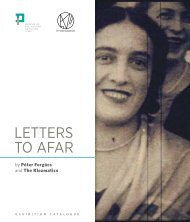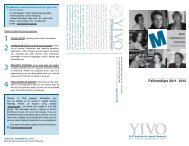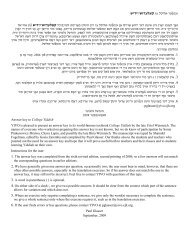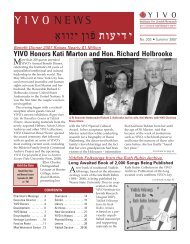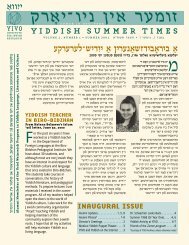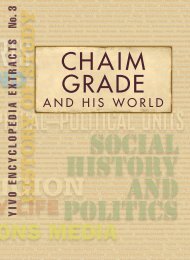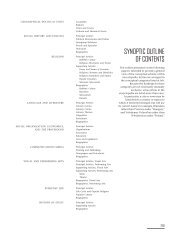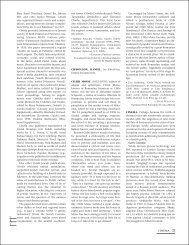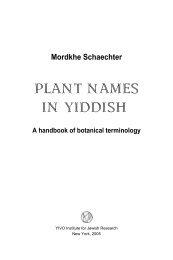Read - YIVO Institute for Jewish Research
Read - YIVO Institute for Jewish Research
Read - YIVO Institute for Jewish Research
You also want an ePaper? Increase the reach of your titles
YUMPU automatically turns print PDFs into web optimized ePapers that Google loves.
SIXccccccccccccccccdxxxxxxxxxxxxxxxxjewish Spaces: Shtetlsand Towns in theNineteenth CenturyI had been accustomed <strong>for</strong> a long time to Lithuania, an ancient land, with ancientcities and villages; the dust of generations lay upon it, and the worry of old agewas like a visible shadow—it was a land that looked backwards . . . That northerncountry was one in which beginnings were no longer made; men could only continuewhat the anonymous and <strong>for</strong>gotten past had begun. In every respect thisrich, young southern country was the antithesis of the northern country of mybirth . . . Here, where the generations had not preempted everything, man couldstill write his name into something.shmarya levin on his move to Odessa in 1898The Arena, New York, 1932In looking at the history of the Jews in the <strong>for</strong>mer Polish lands from around1350 to 1914, the first two volumes of this book concentrate on a numberof issues. The attempts of the government of the Polish–Lithuanian Commonwealthand those which succeeded it to trans<strong>for</strong>m the Jews into citizens or, inthe case of the tsarist empire, into useful subjects, and the <strong>Jewish</strong> responses wereexamined. This was followed by an account of the deterioration, after 1881–2, inthe situation of the Jews in the tsarist empire, the home of the largest <strong>Jewish</strong>community in the world, under the impact of both the rejection by the tsaristgovernment of the policy of integration which it had previously pursued, and thegrowing intensity of the revolutionary crisis. The <strong>Jewish</strong> response to the new situationin the tsarist empire and the character of the ‘new <strong>Jewish</strong> politics’ whicharose there, with its stress on peoplehood or ethnicity rather than religion as themarker <strong>for</strong> <strong>Jewish</strong> identity in the modern world, was then analysed. This was followedby a description of the impact of the new <strong>Jewish</strong> politics on the other partsof partitioned Poland–Lithuania, the Kingdom of Poland, Galicia, and PrussianPoland.These developments were most pronounced in the large towns of the area, inOdessa, Vilna, Kiev, and St Petersburg in the tsarist empire, in Warsaw and ≤ódźin the Kingdom of Poland, in Kraków and Lviv in Galicia, and in Poznań inPrussian Poland. Yet throughout most of the nineteenth century a majority of theJews continued to live in small towns of a pre-industrial type, and in villages inthe countryside. These were affected by change, but much more slowly. The way
<strong>Jewish</strong> Spaces 163of life was very different in these various places. In a famous essay the German<strong>Jewish</strong> sociologist Georg Simmel (1858–1918) has described thepsychological conditions which the metropolis creates. With each crossing of the street,with the tempo and multiplicity of economic, occupational and social life, the city sets up adeep contrast with small town and rural life . . . The metropolis exacts from man as a discriminatingcreature a different degree of consciousness from that required by rural life,where the rhythm of life and sensory mental imagery flows more slowly, more habituallyand more evenly.Simmel highlighted some of the specific features of life in the big city: its intellectualquality, its dependence on production <strong>for</strong> a national and internationalmarket, its extreme division of labour, and the requirement of punctuality which itimposed on those who earned their living here. These characteristics made socialrelationships qualitatively different from those in small towns. The city atomizesits inhabitants and isolates them from each other, which makes them both moreindifferent to each other and also more prone to conflict. At the same time, itaf<strong>for</strong>ds its denizens an unprecedented freedom from the ‘trivialities and prejudiceswhich bind the inhabitants of a small town’. 1This chapter examines the specific conditions in which Jews lived, first in smalland market towns and then in the large towns whose emergence was such a characteristicfeature of nineteenth-century Europe.THE SHTETL IN THE NINETEENTH CENTURYWhen it comes to the nineteenth century, we have nothing that compares with thedetailed studies of Rosman and Hundert on <strong>Jewish</strong> small towns in the seventeenthand eighteenth centuries. The legal situation of the Jews in these towns changedsignificantly. The abolition of serfdom and feudal conditions, first in PrussianPoland and then in Galicia, the Congress Kingdom, and the Pale of Settlement,did away with the rights of the noble owner of the small town. With the exceptionof the tsarist empire, where the laws restricting <strong>Jewish</strong> rights of residence weretightened after 1881, Jews could now live in any part of any town. Throughout thisperiod Jews remained a key element of the rural economy and retained their role asintermediaries between the estate and the village. However, social stratificationbecame more extreme in the <strong>Jewish</strong> small town, as some profited from the commercializationof agriculture and the new links with the outside world while otherswere impoverished by the disappearance of their traditional occupations.We are dependent, above all, on fiction <strong>for</strong> our understanding of what washappening in this period. The maskil Israel Aksenfeld provides a very vividdescription of <strong>Jewish</strong> small towns in the closing years of the Napoleonic period inhis novella Dos shterntikhl (The Headband):1Simmel, ‘The Metropolis and Mental Life’.
164 <strong>Jewish</strong> SpacesAnyone familiar with our Russian Poland knows what Jews mean by a small shtetl, a littletown.A small shtetl has a few cabins, and a fair every other Sunday. The Jews deal in liquor,grain, burlap, or tar. Usually, there’s a man striving to be a Hasidic rebbe.A shtot, on the other hand, contains several hundred wooden homes (that’s what they calla house: a home) and a row of brick shops. There are: a very rich man (a parvenu), severalwell-to-do storekeepers, a few dealers in fields, hareskins, wax, honey, some big moneylenders,who use cash belonging either to the rich man, going halves on the profits, or tothe tenant farmers and tenant innkeepers in the surrounding area. Such a town has a Polishlandowner (the porets) with his manor. He owns the town and some ten villages, this entiredistrict being known as a shlisl [Polish: klucz, ‘key’]. Some prominent Jew, who is held inesteem at the manor, leases the entire town or even the entire district. Such a town also hasa <strong>Jewish</strong> VIP, who is a big shot with the district police chief. Such a town has an intriguer,who is always litigating with the town and the <strong>Jewish</strong> communal administration, even onthe level of the provincial government. In such a town, the landowner tries to get a Hasidicrebbe to take up residence, because if Jews come to him from all over, you can sell themvodka, ale, and mead. All these goods belong to the landowner, and so up goes his income.Such a town has a winehouse keeper, a watchmaker, and a doctor, a past cantor and apresent cantor, a broker, a madman, and an abandoned wife (an agunah), community beadles,and a caterer. Such a town has a tailors’ association, a burial association, a Talmudassociation, and a free-loan association. Such a town has various kinds of synagogues: a shul(mainly <strong>for</strong> the Sabbath and holidays), a bes-medresh (the house of study, <strong>for</strong> everyday use),and sometimes even a kloyzl (a smaller house of worship) or a shtibl (a small hasidic synagogue).God <strong>for</strong>bid that anyone should accidentally blurt out the wrong word and call thetown a shtetl. He’d instantly be branded as the local smartass or madman.A town is called a big town if there are a couple of thousand householders and a few brickbuildings aside from the wooden homes. This is a horse of a different colour. Here, everyoneboasts that he greeted someone from the next street because he mistook him <strong>for</strong> anout-of-towner. After all: In such a big town as this, how can you tell if a stranger is a local?There are tons of people whom you don’t know from Adam. 2This description is helpful in distinguishing the different types of town, but itsaccount of the town’s <strong>Jewish</strong> inhabitants is essentially social satire and shouldnot be taken <strong>for</strong> a representation of reality. For these inhabitants, the shtetl wasa kehilah kedoshah, a holy or covenantal community. As such, it maintained, asAksenfeld describes, the essential institutions of shul (synagogue), beit midrash(study house), shtibls (hasidic houses of prayer), ḥeders (elementary schools),mikveh (ritual bath), and besoylem (beit olam, cemetery). These provided <strong>for</strong> thecommunity’s religious needs just as the various voluntary societies and professionalguilds (ḥevrot) organized the social interaction among the Jews themselves.This ideal often failed to live up to reality, and the maskilim, like Aksenfeld, thussaw the shtetl as the root of <strong>Jewish</strong> backwardness. They were quick to point out2Dos Shterntikhl, in Neugroschel (ed.), The Shtetl, 49–50. The description later says that the eventstake place in 1812–13.
<strong>Jewish</strong> Spaces 165that power was concentrated in the hands of the male householders who electedthe kahal, and they shed no tears when it was abolished by Nicholas I in 1844. Aparticularly bitter attack on the corrupt nature of the shtetl oligarchy is to befound in Di takse (The Tax), an early work of Shalom Jacob Abramowitsch(Mendele Mokher Se<strong>for</strong>im).With the new situation that followed the change in Russian government policyafter 1881, writers like Shalom Abramowitsch, Shalom Aleichem, and Isaac LeibPeretz became much more sympathetic to the shtetl; in their eyes it became a<strong>for</strong>tress of <strong>Jewish</strong> values, beleaguered on all sides, which, despite its poverty andapparent primitiveness, preserved within it authentically <strong>Jewish</strong> spiritual values.Nevertheless, not all writers of this period found the shtetl to be a charmingrepository of virtues lost in the city. Bialik’s poem ‘Betshuvosi’ (Upon My Return)is a savage reflection on the suffocating intellectual isolation of the shtetl and ofhis own feelings of being unable to free himself from its prison-like atmosphere.The members of the next generation of Yiddish writers, Sholem Asch, Isaac MeirWeissenberg, and Dovid Bergelson, each had a new and distinctive image of theshtetl. Asch idealized the shtetl, and also described its ‘tough Jews’ with their closerelations with the non-<strong>Jewish</strong> population, Weissenberg highlighted the classantagonisms among shtetl Jews during the revolution of 1905, while Bergelsondescribed the spiritual emptiness of small-town life in the years after the crushingof the 1905 revolution (on this, see Chapter 7).The literary depiction of the non-<strong>Jewish</strong> inhabitants of such towns in the rarecases when they appear in <strong>Jewish</strong> writing is even more stereotypical and exhibits ahigh degree of continuity, from the literature of the Haskalah to that in modernHebrew and Yiddish in the late nineteenth and early twentieth centuries. 3 Whenthese towns were established, the dominant figure was the Polish landowner, theproprietor and often the founder of the town. Yet by the time a fictionalized imageof the shtetl appeared, his power had effectively been done away with (at least inthe tsarist empire) as a consequence of the Russian suppression of the Polishuprisings of 1830 and 1863 and the abolition of serfdom and unfree cultivation.Hebrew and Yiddish literature abound in descriptions, both positive and negative,of the Polish noble owner of the shtetl. In Ayit tsavua (The Hypocrite; 3 pts,1858, 1861, 1864), a novel written in Hebrew by Abraham Mapu, one finds aridiculously romanticized depiction of the salon of a Lithuanian magnate, whereenlightened Poles and Jews meet to discuss Voltaire, philosophy, and the Jews.More frequent is the negative depiction of the landowner which was also wellestablished both in <strong>Jewish</strong> folklore and in hasidic hagiography, where the tsadikwas able to use his powers of intercession to turn aside aristocratic malevolence.This negative image became more pronounced in the post-Haskalah period. Itwas given characteristic articulation in the works of the Yiddish writer Isaac Leib3On this, see Bartal, ‘Non-Jews and Gentile Society in East European Hebrew and YiddishLiterature 1856–1914’.
166 <strong>Jewish</strong> SpacesPeretz, where, particularly in later stories with their pseudo-folkloric character,the Polish nobleman and particularly the Polish noblewoman become symbols ofthe corruption and licentiousness of the non-<strong>Jewish</strong> world.Fictional treatment of the Russian bureaucracy exhibits a marked shift frompositive to negative. During the period when maskilim still expected the authoritiesto assist them in the re<strong>for</strong>m of the <strong>Jewish</strong> community, Russian officials areoften depicted in a favourable and highly stereotypical way, especially in the worksof Judah Leib Gordon, Abraham Gottlober, and Isaac Joel Linetsky. However,even be<strong>for</strong>e 1881 some writers, such as Shalom Abramowitsch, took a much morenegative view; after that year favourable depictions of Russian officials becomealmost non-existent, to be replaced by the hostile and often buffoonish functionariesof Shalom Aleichem’s Tevye der milkhiker (Tevye the Milkman).Instead there was an idealization of the progressive intelligent, like the revolutionarystudent Romanenko in Shalom Aleichem’s novel In shturm (In the Storm;first called Der mabul, The Deluge, serialized in 1907–8). Peretz was moreambivalent. In his short story ‘In postvogn’ (In the Mail Coach, 1891) he draws asympathetic portrait of Janek Polniewski, a radical member of the intelligentsiawho has abandoned the study of medicine to become a provincial pharmacistand who rejects antisemitism as ‘a kind of cholera, an epidemic’. The narrator ofthe story is set at ease by the reassurances of his long-lost friend, but is instantlysuspicious when the latter ascribes his friendly feelings towards the Jews to anencounter with a <strong>Jewish</strong> woman. He reflects: ‘What do you think? That his consciencewould hold him back? From a young <strong>Jewish</strong> wife! Why not? Once to gainglory, it was necessary to bring Jews to baptism; today it is enough to seduce a<strong>Jewish</strong> woman by drawing her away from her God, from her parents, from herhusband—from her whole life.’ 4 In the end, however, the narrator accepts that hissuspicions are baseless.The depiction of peasants, with whom the Jews in the small towns were in constantcontact, whether on market day, as co-inhabitants of the shtetl, or as servantsand clients, was closer to reality but also strongly stereotypical. Thus, eventhough Shalom Abramowitsch felt an instinctive sympathy with the poor andoppressed peasantry, he still saw them as primitive and prone to violence. He alsohighlights the gulf between Jews and peasants. In Kitsur masos Binyomin hashlishi(The Brief Tales of Benjamin the Third, 1878) the protagonists, Benjamin andSendrel, barely have a common language with a peasant they encounter as theybegin their search <strong>for</strong> the ten lost tribes.Sendrel rose, walked over to the peasant, and said as politely as he could: ‘Dobry dyen! Kozhino tshelovitshe kudi dorogi Eretz-Yisro’eyl? [Good Day! Tell me, Sir, how does one go to EretsYisrael?]’ ‘Shtsho? [What?]’ asked the peasant, eyeing him bewilderedly. ‘Yaki Yisro’eyl? Nyebatshil ya Yisro’eyl [What Israel? I haven’t seen any Israel].’4Repr. in Peretz, The I. L. Peretz <strong>Read</strong>er, 112, 116.
<strong>Jewish</strong> Spaces 167‘Nye, Nye [No, No],’ interrupted Benjamin impatiently from where he sat. ‘He thinksyou’re asking about a person named Israel, not about the land.’ . . . The peasant spat, toldthem both to go to the Devil, and drove away muttering: ‘Eres-Srul, Eres-Srul!’ 5Peretz, particularly in his socialist period, had more sympathy with the peasantry.In the short story Dos shtrayml (The Fur Hat, 1893) the narrator, a tailor,remarks that he enjoys making peasant coats, since ‘the peasant gives us bread, hedoes hard and bitter work in the summer and I cannot protect him from the sun,so he should at least be protected from the cold, during the winter, when herests’. 6Non-<strong>Jewish</strong> servants working in <strong>Jewish</strong> households also appear in many stories.Shalom Aleichem describes Hapke, a Ukrainian maid in a <strong>Jewish</strong> household:‘Hapke spoke Yiddish like a Jew and used in her speech a mass of phrases in loshnkoydesh[literally “holy language”: <strong>Jewish</strong> religious terms, usually derived fromHebrew or Aramaic]. When she spoke of Hveydor [another servant], she referredto him as a kapoernik [a derogatory term <strong>for</strong> a non-Jew]’. 7The treatment of Christianity, whether in its Roman Catholic or its RussianOrthodox version, is <strong>for</strong> the most part negative, although some distinctions aredrawn. Thus, one does sometimes find sympathetic portraits of enlightenedhigher Catholic clergy, particularly in the period be<strong>for</strong>e 1881.Peretz sharply contrasted the pre-modern period, when religious coexistencehad been a feature of shtetl life and the modern period, when antisemitismbecame the stock-in-trade of the parish priest. He describes the change in hisstory ‘Der drong’ (The Pole):Previously there had been a good priest, roly-poly, smiling, with red cheeks and laughinggrey eyes . . . He was friendly with the Jews . . . He used to lend a rouble from time to timeagainst some pawn and without high interest . . . Be<strong>for</strong>e the sabbath and holidays he was aredeemer and saviour . . .While the old priest had maintained good economic relations with the Jews, the new onewas an antisemite who promoted the anti-<strong>Jewish</strong> boycott in his sermons.He often referred to that story, the old tale of the hanged man [i.e. Jesus] . . . ‘Be careful,’he says, ‘you should not deal with any Jew, neither buy nor sell.’ If they don’t listen, herefuses confession, won’t grant absolution. ‘Let their souls burn in hell <strong>for</strong> ever,’ he says. 8We also have non-<strong>Jewish</strong> (predominantly Polish) descriptions of the shtetl,both positive and negative. In the Polish literature of the Enlightenment, discussionsof the shtetl are primarily used to explain the backwardness and destitutionof Polish towns, <strong>for</strong> which the Jews are frequently held responsible. Such is thetreatment of the shtetl in Ignacy Krasicki’s Pan Podstoli (Mr Pantler; 3 pts, 1778,1784, 1803) and Micha≥ Krajewski’s Podolanka w stanie natury wychowana (A Girl5Abramowitsch, The Brief Travels of Benjamin the Third, 334.6Peretz, Complete Works (Yid.), vi: For Great and Small [Far kleyn un groys], 130.7Shalom Aleichem, Works (Yid.), xvi. 92.8Peretz, Works (Yid.), vii: Pictures and Sketches [Bilder un skitsn], 210–11.
168 <strong>Jewish</strong> Spacesfrom Podolia Raised in a State of Nature, 1784). This view of the shtetl persistedin the literature of the early nineteenth century, permeated as it was by the principlesof the Enlightenment. Thus, in the novel Podróż do Ciemnogrodu (A Trip toBackwoodsville, 1820), by Stanis≥aw Kostka Potocki, chairman of the Council ofState and of the Council of Ministers during the Duchy of Warsaw and ministerof education in the Kingdom of Poland between 1815 and his death in 1821, thetraveller passes through ‘muddy unpaved streets, covered with boards here andthere, low houses, only a tenth of them made of brick, Jews and beggars everywhere. . . ill-built muddy towns, full of monasteries and Jews’. 9There were also more positive Polish versions. The romantic novelist JózefIgnacy Kraszewski, in his Latarnia czarnoksięska (The Magic Lantern, 1844),focuses on the attractive features of the shtetl: ‘And do you know what makesevery town Polish? The Jews. When there are no more Jews, we enter an aliencountry and feel, accustomed as we are to their good sense and services, as ifsomething were not quite right.’ 10It is the interwar writer Ksawery Pruszyński who in 1937 gave the classic sentimentaldescription of the Polish noble town in his account of Krzemieniec(Kremenets):Here it stands be<strong>for</strong>e me, Krzemieniec the jewel, the most beautiful of Polish towns andhow Polish it is. In the depths of the ravine, <strong>for</strong>mer nobleman’s houses, bulging and white,with columns and with dark eyes <strong>for</strong> windows, in the crush of streets converge the <strong>Jewish</strong>houses with fringed porches around them, like the inn in Pan Tadeusz. There are two typesof Polish towns, those from the Piast period and those from the Jagiellonian period, thewestern and the eastern towns. The <strong>for</strong>mer were built by Germans and Italians, the latterby the nobleman and the Jew. Krzemieniec is the purest example of the latter. 11George Orwell has observed that a cliché is the easiest way to convey complexin<strong>for</strong>mation in a condensed manner. In this sense, all these descriptions, howeverclichéd, do have an element of reality. But they hardly begin to describe the complexityof social interactions both within the small town and between it and theoutside world.What was the shtetl like in the nineteenth century? There are a number ofvaluable sources. 12 The memoirs of Yehezkel Kotik are particularly useful. Onenew development in the shtetl which he highlights is the impact of hasidism, towhich Aksenfeld also alluded. Even in his home town of Kamenets in the provinceof Grodno, hasidism found many followers, including his own father, who brokewith his family to become a follower of the tsadik of Kobrin. As Kotik pointsout, in traditional rabbinic Judaism prestige was measured by ‘lineage of wealthand lineage of learning’. Hence, ‘the penniless and the illiterate felt degraded9Potocki, Podróż do Ciemnogrodu, i. 29, 146.10Kraszewski, Latarnia czarnoksięska, 271.11Pruszyński, Podróż po Polsce.12Kotik, Journey to a Nineteenth-Century Shtetl. Also very useful is Lukin and Khaimovich (eds.), 100evreiskikh mestechek Ukrainy, i and ii: Podolia.
<strong>Jewish</strong> Spaces 169and humiliated by their treatment in the synagogues and study houses’, while ‘tothe simple Jew Hasidism brought genuine happiness. He became worthy.’ 13 Thevisit of the rebbe to Kamenets was a major occasion <strong>for</strong> his local followers:Once a year, the rebbe himself came to Kamenets. His arrival was preceded by three weeksof preparations, <strong>for</strong> in his wake hasidim from Brisk and all the surrounding shtetls wouldflock in. When the rebbe arrived, people stood in awe of him, as if he were the tsar himself.Hundreds of them ran to meet the carriage that brought their rebbe, and they led him intothe township with great ceremony . . . every hasid trembled be<strong>for</strong>e the rebbe and felt theawe-inspiring presence of royalty be<strong>for</strong>e him. 14Towns where a tsadik settled and established his court were trans<strong>for</strong>med. Wehave a good description by Pinhas Minkowski of the court of the tsadik DavidTwersky (1808–82) in Talnoe (Yiddish: Talne), where he was a cantor:Sprawling over a spacious meadow in the middle of the town of Talne . . . was a great court,surrounded on all sides by a fence, like a little townlet on its own, containing large and marvellouslymagnificent buildings, like little palaces: a palace <strong>for</strong> the rebbe’s wife, a palace <strong>for</strong>their only son, Mottele, a palace <strong>for</strong> their son-in-law, Meirel . . . a special palace <strong>for</strong> thecourt manager . . . and other houses specially <strong>for</strong> the Beshtian great-grandchildren andgrandchildren, who had settled there <strong>for</strong> life and lived com<strong>for</strong>tably at the expense of thecommunity and the zaddik . . . and of course there was the house of the zaddik which surpassedall others in beauty and glory.Built in this court was the rebbe’s great kloiz, which could accommodate about two thousandpeople, in addition to a large hall and a corridor, protruding from the southern wall ofthe kloiz, with a door opening into the kloiz so that the zaddik while praying alone in hishall, could also pray with the public. In the middle of the court was a large, long woodenbuilding, used as a banquet hall <strong>for</strong> meals on Sabbaths and festivals, <strong>for</strong> the zaddik and hisintimates . . . 15Pilgrimages to the tombs of tsadikim also became a feature of life in <strong>Jewish</strong>eastern Europe, usually to participate in the annual service on the anniversary ofthe death of the founding tsadik or one of his successors. One such site of venerationwas the tomb of the Besht in Medzhybizh.Religious belief remained strong in the shtetl. We have a very vivid descriptionby the Yiddish writer S. Y. Ansky of his experiences in 1881 when, as a youth of 17,he tried to bring the principles of the Haskalah to the small town of Liozno. Hesucceeded in creating a youthful circle of ‘maskilim’, which was soon discovered.Fortunately, the copy of Ḥate’ot ne’urim (Sins of Youth, a classic maskilic autobiographyby Moses Leib Lilienblum) was bound with a story by Judah LeibGordon which could not be regarded as heretical, and the threat of excommunicationwas lifted from Ansky. However, tighter control over the young people was13 14Kotik, Journey to a Nineteenth-Century Shtetl, 400, 406. Ibid. 199.15P. Minkowski, ‘From the Book of my Life’ (Heb.), Reshumot, 1 (1918), 113, quoted in Assaf, TheRegal Way, 269–70.
170 <strong>Jewish</strong> Spacesestablished and it was decreed that ‘A search should be made in all homes and inall attics; all books, except religious books, that might be found were to bebrought the next day to the synagogue courtyard <strong>for</strong> burning so that evil shouldbe purged from the town.’ Ansky himself was <strong>for</strong>ced to leave the town. 16At the same time the old religious certainties were weakening. Kotik describeshow he was alienated by the hasidic adulation of the rebbe and the poverty andhunger among hasidic families, in which the men seemed to show little concern<strong>for</strong> the fate of their wives and children. He himself broke with his father’s beliefsand moved to Warsaw. 17Kotik also describes the waning of the influence of the Polish noble owner ofthe town and the growing power of the Russian administration, in the personof the district governor, whose influence increased still further after the abolitionof serfdom.There was also a widespread feeling that the shtetl and its particular way of lifewas disappearing. In a review of the memoirs published in Di tsukunft (TheFuture) in New York in September 1913, Moses Katz wrote that ‘The <strong>Jewish</strong>shtetl is dying. This small self-enclosed world is disappearing and with it theflavour and the song of the past which modern Jews now yearn <strong>for</strong>.’ 18 This wasalso the view of Kotik himself. In the section of his memoirs, entitled ‘Instead ofan Introduction’, he wrote:I spent my youth in a small typical shtetl where Jews live a poor but ‘quiet’ and, if one maysay, flavourful life . . . This no longer exists today; the poetry of those <strong>for</strong>mer shtetls hasbeen silenced too. The immigration to America has thinned them out and the arduous life<strong>for</strong> Jews in Russia which is filled with the black lead of antisemitism has entirely ruinedthem. These gracious <strong>Jewish</strong> towns, which were weaker than the <strong>Jewish</strong> cities, were thefirst to die . . . 19 JEWS IN LARGE TOWNS TO 1914Population growth and urbanization were among the most significant features ofthe ‘long nineteenth century’ in Europe. Between 1760 and 1880 the continent’spopulation grew from about 150 million to about 330 million inhabitants. By 1914it stood at around 480 million. Population growth was particularly rapid in easternEurope: the tsarist empire in 1914 had a population of over 140 million havingmore than tripled from 1820 when its population was 46 million. Until 1880 therural population of the continent remained stable, the increase in the size of townsand cities resulting above all from their absorption of the rural surplus. After thatdate the European countryside began to empty, first in the west and then moreslowly in the centre and east, contributing further to the urbanization of the continent.Whereas in 1850 only 45 European towns had more than 100,000 inhabi-16Ansky, ‘I Enlighten a Shtetl’.17Kotik, Journey to a Nineteenth-Century Shtetl, 409.18Quoted ibid. 55.19Ibid. 103.






